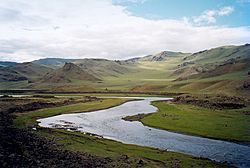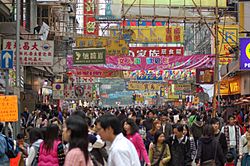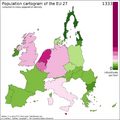Population density facts for kids

The population density of a country or city or other place is a number showing how crowded that place is. It is calculated by dividing the population by the area. For example, France has a population of 60,561,200, and an area of 551,695 square kilometres, so its population density is about 109.8 persons per square kilometre.
A number of factors can affect population density. For example, the climate. Greenland has a very low population density because it is very cold there, so not many people want to live there.
Many cities were built near rivers, because the first settlers wanted somewhere close to water to start a society, so areas around rivers often have a high population density.
Some places, such as cities, have very high population densities, so they are quite crowded. The population density of New York City is 10,292 persons per square kilometre. Other places, such as large countries, can have very low population densities. The population density of Canada is only 3.8 persons per square kilometre because it is such a big country.
The country with the highest population density in the world is Monaco, with 16,620 persons per square kilometre. The country with the lowest is Greenland, which has only 0.03 persons per square kilometre.
Images for kids
-
Population density (people per km2) map of the world in 1994. In relation to the equator it is seen that the vast majority of the human population lives in the Northern Hemisphere, as 67% of Earth's land area is there.
-
Monaco is currently the most densely populated nation in Europe.
-
Mongolian Steppes. Mongolia is the least densely populated country in the world due to its harsh climate as a result of its geography.
See also
 In Spanish: Densidad de población para niños
In Spanish: Densidad de población para niños








